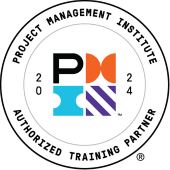Project Risk Management – 2 Days, 14 PDUs
Learning Objectives
- Define risk management and discuss the importance of the Uncertainty Performance Domain.
- Understand the importance of risk assessment from project initiation through closing.
- Discuss roles and responsibilities of various stakeholders in risk management
- To develop a comprehensive risk management plan that can be used throughout the project and on future projects.
- Discuss the process of risk management including identify activities, perform qualitative and quantitative analysis, plan risk responses, implement risk responses, and monitor risks
Course Overview and Agenda
The objective of Risk Management is to introduce the students to basic risk assessment and management concepts that can be applied directly to their projects. Using a discussion and exercise format, the students will learn risk management following the foundation provided in the Guide to the Project Management Body of Knowledge (PMBOK® Guide) established by the Project Management Institute (PMI). Student will perform a risk assessment using project data from a project of their choosing. Upon completing the class students will understand all aspects of risk assessment including risk management planning, risk identification, qualitative and quantitative risk analysis, risk response planning, and implementing and monitoring risks.
Introduction
- Key Terms and Concepts
- System For Value Delivery (Figure 2-2)
- Project Constraints
- Cost of Rework
- Management of Expectations
- Influence of Risk Across the Project Lifecycle
- Optimize Risk Responses (Figure 3-11)
- Uncertainty Performance Domain (Figure 2.32)
- Definitions
- General Uncertainty
- Ambiguity
- Complexity
- Volatility
- Risk
- Interaction with Other Performance Domains
- Checking Results (Figure 2-10)
- Role of the Project Manager in Risk Assessment
- Role of the Project Team and Subject Matter Experts in Risk Assessment
Initiating
- Develop Project Charter
- Contents of the Project Charter
- Identify Stakeholders
- Power/Interest Grid
- High Level Risk Assessment
- Exercise: Project Charter and High-Level Risk Assessment
Planning
- Project Management Plan
- Project/Product Analysis
- Project Analysis Checklist and Survey (PACS)
- Sample Project Management Plan
- Risk Management Process
1. Plan Risk Management
- Risk Management Process
- Organizational Risk Tolerance
- Probability and Impact Matrix
- Impact Matrix
- Contingency Reserve
- Management Reserve
- Risk Management Plan
Exercise: Risk Management Plan
2. Identify Risks
- Identify Risk Process
- Risk Identification Techniques
- Risk Triggers
- Risk Owners
- Risk Register Creation
Exercise: Risk Identification
3. Perform Qualitative Risk Analysis
- Qualitative Risk Analysis Process
- Probability of Occurrence
- Impact on Project Objectives
- Risk Score
- Risk Register Updates
Exercise: Risk Prioritization
4. Perform Quantitative Risk Analysis
- Quantitative Risk Analysis Process
- Expected Monetary Value
- Contingency Reserve vs. Management Reserve
- Decision Tree Analysis
- Simulation Models
- Risk Register Updates
Exercise: Calculating Expected Monetary Value
5. Plan Risk Responses
- Risk Response Process
- Risk Response Strategies
- Contingency and Fallback Plans
- Residual Risks vs. Secondary Risks
- Risk Register Updates
- Project Management Plan Updates
Exercise: Risk Response Creation and Project Management Plan Updates
Executing, Monitoring and Controlling
1. Implement Risk Responses
- Implement Risk Response Process
- Expert Judgment
- Interpersonal and Team Skills
- Project Management Information Skills
- Change Requests
- Project Documents Updates
2. Monitor Risks
- Monitor Risk Process
- Updating the Contingency Reserve
- Risk Register Updates
- Managing impacts on the project
Exercise: Risk Register and Contingency Reserve Update


